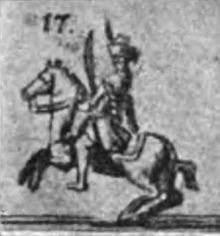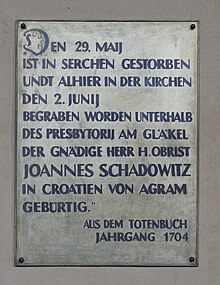Johann Schadowitz
Janko Šajatović , translated as Johann (es) Schadowitz (* 1624 in Žumberak (Sichelberg) , Agram County , Kingdom of Croatia ; † May 29, 1704 in Särchen , Upper Lusatia ), was a Croatian rider in the Croatian personal company on the horse of Elector Johann Georg II . of Saxony . Under the subsequent Saxon Elector Johann Georg III. Schadowitz became a colonel and brigade chief of the entire guard cavalry . From 1691 he was lord of Vorwerk Särchen in Upper Lusatia. Schadowitz is considered to be the historical model for the Sorbian mythical figure of the magician Krabat, which is still popular in Lusatia .
Life
Origin and Saxon Croatian bodyguard

Born in Žumberak (Sichelberg) , in the Žumberak region belonging to Agram County , Schadowitz probably came from a family of Uskoks . The Habsburg monarchy first settled Uskoken in this area in 1530 to compensate for the population loss caused by the Turkish wars in the middle of the 15th century .
Schadowitz belonged to the "Leib Compagnie Croaten zu Ross", formed in 1660 by Elector Johann Georg II of Saxony . Commander of initially 87 and later up to 150 strong man company who was captain and later Lieutenant Colonel Count Janko Peranski († 1689), who for his services to the chamberlain and bailiff of Moritzburg was appointed. In 1680, the son and successor of Johann Georg II, Elector Johann Georg III. , this unit for cost reasons.
Chief of the Guard Cavalry
Schadowitz continued to serve in the electoral regiment on horseback before he came as Rittmeister to the Guard Cavalry (Trabanten-Life Guards on Horseback) and took part in the Battle of Kahlenberg in the Great Turkish War (1683–1699) . Among other things, it is documented that he was Johann Georg III. accompanied when he visited Hoyerswerda from February 4th to 7th, 1688 with 130 people and 15 horses . Due to his war experience, proven bravery in many skirmishes and long service, Schadowitz became brigade chief of the entire electoral guards cavalry on May 1, 1690 . As such, he led the funeral procession for Johann Georg III in the autumn of 1691 . in Tübingen the electoral bodyguard. Allegedly, shortly before the Elector's death, Schadowitz is said to have received the Särchen manor as a retirement home for his services and to have been ennobled .
Retirement and death
On December 12, 1691, the day after the funeral of Johann Georg III. in Freiberg Cathedral , his successor Johann Georg IV went to the guard cavalry on the firing range and abdicated Schadowitz. The Elector had already granted him a monthly pension of 100 Reichstalers on November 24, 1691 , which Schadowitz was confirmed on June 11, 1694 by the subsequent Elector and King August the Strong . In the Fourier slip of 1700, Schadowitz is listed among the king's adjutants general . In retirement, Schadowitz received an annual deputation of several thousand Reichstalers for the purchase of fish ( carp , pike ), country wine , firewood and “pensions and pensions from Upper Lusatia”. As a practicing Catholic , he is said to have driven from the Evangelical Särchen to Wittichenau almost every day in order to be able to take part in the Holy Mass . Schadowitz died on May 29, 1704 at the age of 80. He was buried on June 2, 1704 after a funeral sermon in the presbytery , by the changing bell , in the immediate vicinity of the altar of the Catholic parish church in Wittichenau.
Legends and remembrance

Särchen experienced a heyday under Schadowitz, which contributed to the later formation of legends . Because of his unusual size, behavior, strange pronunciation of Sorbian and knowledge, he was considered a magician by the rural population . Schadowitz was called Krabat by the population , the older form for Croatian (from the outdated Croatian horvat ; Sorbian chorwat ). In 1848 the claim is first documented that Schadowitz and Krabat are said to have been the same person:
“In 1795, when Pastor Georg Brückner was buried in the same place, the Colonel's sword was still found there. This Croat Schadowitz is the same one that is known in our area under the name Krabat: because “Croat” has been popularly transformed into “Krabat”. The Croat was rich - Herr von Särchen - and had the reputation of being a black artist . "
When the parish church of Wittichenau was completely renovated between 1933 and 1935 by the Dresden architect Robert B. Witte , the grave of Schadowitz was opened on July 3, 1933. The bones he found were put together, photographed and buried again.
Schadowitz, remembered through folk tales and literature , was solemnly commemorated on the 300th anniversary of his death in Wittichenau and Gross Särchen. On May 29, 2004 the world premiere of Te Deum Laudamus , composed by the Hoyerswerda cantor Johannes Leue, took place in the Evangelical Church of Groß Särchen , with three choirs , soloists , strings and wind instruments .
Others
From January 28th to April 10th, 2020 in the Ethnographic Museum in Zagreb the exhibition entitled HRVATI - LJUDI IZA MITA - Janko Šajatović Krabat i hrvatske garde u Europi [The Croats - The People Behind the Myth - Janko Šajatović Krabat and the Croatian Garden in Europe].
See also
literature
- Krabat - aspects of a Sorbian legend. Center for Teacher Education at the University of Potsdam, editor Martin Neumann; The document contains the contents of various Krabat legends and historical references, also to Schadowitz ( opus.kobv.de PDF; 10.6 MB).
- Karin Richter: Krabat and the Black Mill. The Sorbian legend in a literary, ethical, historical and media context . Schneider Verlag Hohengehren GmbH, Baltmannsweiler 2010.
- Marie-Luise Ehrhardt: The Krabat legend. Source studies on the tradition and effect of a literary material from Lusatia (= cultural and intellectual history studies of East Central Europe . Volume 1 ). NG Elwert, Marburg 1982, ISBN 3-7708-0715-4 .
Web links
- Žumberački plemić Šajatović (The Žumberačk nobleman Šajatović). Retrieved February 27, 2016 (Croatian, with images of his handwritten signature and his coat of arms).
- Johannes Schadowitz alias Krabat: The Sorbian legend in a literary, ethical, historical and media context . Compiled by Ivica Košak, Croatian Cultural Community Wiesbaden eV (www. Hkz-wi.de). (PDF)Retrieved February 26, 2015.
Individual evidence
- ↑ Contemporary eingedeutscht also Jankho Schajatowitsch (1661). Jean de Sajatowitz also personally wrote in French court language . In later sources also Janko Sajadowitz (1762), Janco Sagatowitz (1866) or Janko Sajatowitz (1894).
- ^ Also Schadewitz (1903). (In the back translation from German currently Sorbian Jan Šadowic and Croatian Ivan Šadović ).
- ^ Entry in the recruiting list of the Croatian personal company on horseback from 1661: "Jankho Schajatowitsch von Süchelberg from Croatia: Horse: 2".
- ↑ Excerpt from a copper engraving by Gabriel Tzschimmer : The most serene gathering or historical narration, what the most serene prince and lord, Mr Johann Georg der Ander, Duke of Saxony, etc., in the presence of His electoral serenity, most honored gentlemen, brothers of the wives, princes and princesses in peculiar honors and amusement in the Residenz un Haubt-Vestung Dresden in the month of February of the 1678th year with all kinds of acts, knightly exercises, shows, shooting, hunting, operas, comedy [...] Johann Hoffmann, Nuremberg 1680 (Tzschimmer's best-known work; originated in Commissioned by Elector Johann Georg II on the occasion of his meeting with his brothers, the dukes of the three Albertine secondary school principalities in 1678.).
- ↑ Helmut Schippel: In the footsteps of a Croat. In: Saxon newspaper. February 12, 2015, accessed April 13, 2020 .
- ↑ Salomon Gottlob Frentzel: Historical show place or chronicle and description of the royal and electoral Saxon city and rulership Hoyerswerda in the Marggraffthume Ober-Laußitz . David Richter, Leipzig and Budißin 1744, p. 285 ( books.google.de - there “Rittmeister von Schadewitz”).
- ↑ August von Minckwitz: The first electoral bodyguards on horseback and on foot and their history . Ed .: Georg von Schimpff. Dresden 1894, p. 40 .
- ^ Richard Albert von Meerheimb: Experiences of a veteran of the great army during the campaign in Russia in 1812 . Meinhold, 1860, p. 319 or 321 ( books.google.de - there “Colonel Sajadowitz”).
- ↑ Eberhard Werner Happel: The Bavarian Max, or so-called European history novel, on the 1691st year; In which in a love and hero story the most memorable miracle treats . Wagner, 1692, p. 283 ( books.google.de - there “Obrist-Lieutenant von Schadewitz”).
- ↑ Heinrich Spilner: Kurtze description and origin Alt-Dreßden even Itziger Churfl. Saxon. Residence and main vestibule Neu-Dreßden . Johann Christoph Miethen, Dresden 1708, p. 69 ( books.google.de - there "Obriste Schadewitz").
- ↑ August von Minckwitz: The first electoral bodyguards on horseback and on foot and their history . Ed .: Georg von Schimpff. Dresden 1894, p. 41 (Short biography under footnote no. 55 without knowledge of the historical person: “No news of the conclusion of his résumé has been received.” [Sic!]).
- ↑ Daniel Gottfried Schreber: Chursächsischer former Cammer salary budget . In: D. Daniel Gottfried Schreber's collection of various writings which impact the economic, policey and cameral sciences as well . JJ Curtis, 1762, p. 157 ( books.google.de - there “Obristen Sajadowitz”).
- ^ Book of the dead of the Catholic parish church in Wittichenau . 1704 ("Serchen The 29th of May died in Serchen and was buried here in the church on the 2nd of June, entertaining the Presbytonj on the bell of the gracious Mr. H. Colonel Joannes Schadowitz in Croatia from Agram. He was given a dear sermon. Aet 80 . on.").
- ^ Jacob Grimm, Wilhelm Grimm, Rudolf Hildebrand: German dictionary . tape 5 (letter K). Hirzel, 1873 ( books.google.de - article “KRABAT, KRABATE”).
- ^ Franz Schneider: Chronicle of Wittichenau and the surrounding area . tape 1: 1848-1852 , pp. 145 f . (Handwriting, quoted from EHRHARD, 1982, p. 83).
- ^ Catholic parish of St. Mariä Himmelfahrt Wittichenau: tour of the parish church. Retrieved on February 26, 2015 (item “Memorial plaque to Johann Schadowitz”, 2nd page, with the photo of the bones).
- ↑ HRVATI - LJUDI IZA MITA - Janko Šajatović Krabat i hrvatske garde u Europi. Ethnographic Museum Zagreb (emz.hr), accessed on January 26, 2020 .
| personal data | |
|---|---|
| SURNAME | Schadowitz, Johann |
| ALTERNATIVE NAMES | Schadowitz, Johannes; Schadewitz, Johann; Schadewitz, Johannes; Šajatović, Janko (Croatian); Schajatowitsch, Jankho; Sajadowitz, Janko; Sajatowitz, Janko; Sagatowitz, Janco; Sajatowitz, Jean de (French); Krabat (nickname); Croatian (nickname) |
| BRIEF DESCRIPTION | Colonel of Croatian horsemen and landlord |
| DATE OF BIRTH | 1624 |
| PLACE OF BIRTH | Žumberak (Sichelberg) |
| DATE OF DEATH | May 29, 1704 |
| Place of death | Särchen |